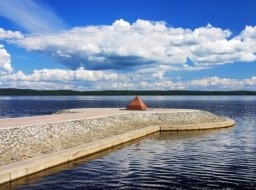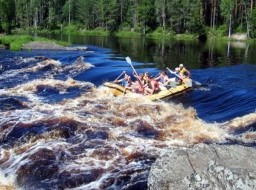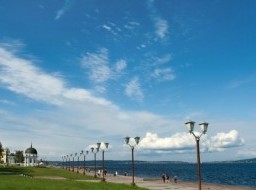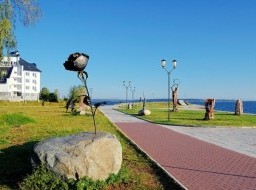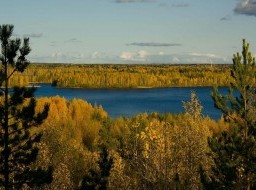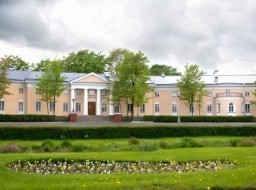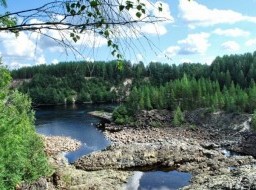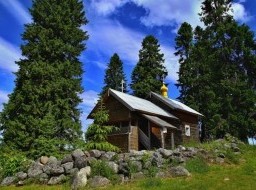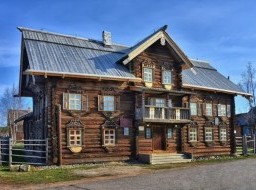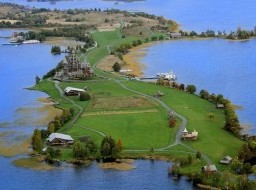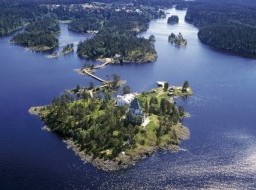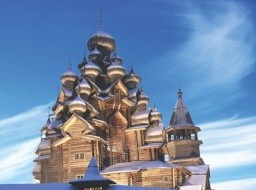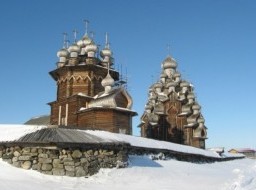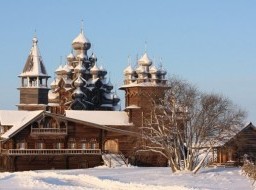Since its foundation the history of Petrozavodsk has been connected with the name of St. Alexander Nevsky. He was considered the heavenly protector of Novgorod district, including Karelian pogosts. In 1774 all the Russia celebrated the 50th anniversary since removing the relics of the St.Alexander Nevsky into Alexandro-Nevsky monastery, erected on the banks of the river Neva at the place of the first great prince's victory over Sweden. At the same time in Petrovsky sloboda a new factory has been built, which was located a bit higher than the old one along the flow of the Lososinka river. It was named after great prince Alexander Nevsky by Ekaterina the Second's decree.
Alexandrovsky foundry cast cannons to defend the motherland, and on Sundays and holidays the workers used to go to the Trinity church, located near Zaretsky cemetery next to the old church of the Cross Exaltation. The church was small and shabby, and that's why it was decided to build a new factory church made of stone. The place for the construction of a new church was marked on the Petrozavodsk map of 1885 affirmed by Mikhail the Longarmed, on the right bank of the Lososinka river, not far from Alexandrovsky foundry.
Right Reverend Seraphim, metropolitan of Novgorod blessed the construction of a new temple, and on April 25 in 1825 the Department of mining gave a permission to build a new church .
A competition for the projects of a new church was announced. Three architects presented their works: Jiacomo Quarengi, Geste and Alexander Ivanovich Postnikov. Postnikov's project won because it had met the financial resources of the factory. To construct the church a special commission was organized on February 23 in 1826 under the chairmanship of the manager of Olonetsky mining works Adam. V. Armstrong.
Since the very beginning it was decided to build the church on donations of the foundry workers. It was a term of Novgorodsky spiritual consistory "only for voluntary donation construction" The money for the church building were sent to a special fund. In the papers of Alexandrovsky foundry the lists of workers, sent their donations for the church construction are still kept.
Preparation for the construction was started in 1825. The main works were made by peasant's artels from different uyezds of Olonetsky province. They prepared building materials: stone, wood, lime.
Stone works masters were headed by Pjetro Karlo Moderni who has Italian backgrounds. He had been the chief works for two years - from 1826 till 1828. All the works had been accomplished in time and with good quality. Decorating works in the temple were made by master Vikula Jevstafjev from St.Petersburg and a peasant from Kostromskaya province Timophey Kozmin with his artel, the works had been accomplished by September 8, 1831. The roof works were made by Kholmogorsky artel headed by St.Petersburg master Chernyaev, but many works, including decoration were made by local masters of the town and villages. The construction appeared to be more expensive than it had been supposed before. The builders were short of money, that's why the treasury released a solid sum for completion of the works.
It is interesting to follow the history of the first bell of Alexandro-Nevsky church. When the church was nearly accomplished, the citizens faced the problem of the bell. A factory priest Jakov Vasilevsky petitioned for moving the bell from the old Trinity church to a new one. Right Reverend Ignatiy, Olonetsky bishop, gave a permission and the bell was moved to a new church. This bell was cast in 1813 out of old broken bells in Belozersk. "Belozersky posadnik Mikhailo Groshnikov received fifty five poods of copper to recast old broken bells and make a new one..." The bell weighed 53 poods and it served in the old Trinity church, and then it was moved to a new factory church. The bell tower of Alexander Nevsky church located in the church rectangle tower facing the South, the bells were hanging on wooden beams. All in all there were eight bells: the first one weighed 157 poods (a pood is equal 16 kg) 34 pounds (a pound is equal 400 gr), the second, the one cast in Belozersk and moved from the Trinity church weighed 53 poods, the third one weighed 18 poods 22 pounds, the fourth one weighed 10 poods 22 pounds, the first one weighed 5 poods 12 pounds, the sixth one weighed 2 poods 4 and a half pounds, the seventh one weighed 1 pood and 5 and half pounds, the eighth one weighed 21 pounds.
The iconostasis works were made under the leadership of Kegsholm master Alexei Bobrov, the icons for a new temple were painted by an artist Alexander Chizhov. Mostly they were exact replicas of Moscow and St.Petersburg icons.
The factory church of St.Alexander Nevsky, 1901The factory church of St.Alexander Nevsky 1901The church was built under participation of the whole city and even the whole province andby the early 1832 the construction had been accomplished. On January 27 at the day of St.John Rhetorican, Right Reverend Ignatiy the first Olonetsky bishop, blessed the main altar in the name of St. righteous great prince Alexander Nevsky. The side altars were blessed in the name of the Trinity and St.Nickolai Miracle-worker.
Finally a new factory church made of stone in the name St. great prince Alexander Nevsky came into being in the town.
The temple, built in a style of Russian classicism, added the charm to the town and was one of the largest stone edifices in Petrozavodsk in the first half of XIX century
The temple was the center of spiritual life of the workers for the whole century. Here the names of the babies after being baptized were written down by a priest in the main document called a metrical book. When the babies grew up and got married, after the wedding ceremony, he again made a note in the book, and their children over and over were written in the book, and when the time came to pass away, their names for the last time were written in the book after the burial service. So all their lives were reflected in the book and were connected with the temple.
On January 17, 1888 a church school was opened attached to the mining factory church. The school served the employees` children, and the church helped them grow spiritually.
During the Soviet times the temple was closed down,in 1929 it was rendered to the museum of folk lore. The museum had been located here till the decision of Minister Council of Karelian ASSR accepted in 1990. According to the decision the historical buildings located on former Round Square (now it is called Lenin's Square) to house the museum of Karelian folk lore. The museum managed to move only in 1993, and after that restoration works were started.
Fortunately for all orthodox believers this temple, though a bit reconstructed, was kept till present days. It certainly was in God's plans to keep the church and to make a beautiful cathedral in the restored eparchy.
The temple has been constructed (from 1825 till 1832),and also for seven years it had been restored for nearly seven years. In 1993 ÀÎ "Lad" started the restoration works.
At the days of St. righteous prince Alexander Nevsky public prayers were served first outside the temple and then inside it. The services were led by bishop of Petrozavodsk and Karelia Right Reverend Manuil. At the Victory day of the 50th anniversary since the end of the Second World War a festive service was made in the temple, the first one after restoration. Since that day an active revival of the temple-monument has been started.
On July 30, 996 the orthodox crosses were blessed by bishop of Petrozavodsk and Karelia Right Reverend Manuil. Alexandro- Nevsky church became a cathedral of Petrozavodsk and Karelian eparchy, and bishop's cathedral is also located here.
The monument of the architecture of the first half of XIX century has been restored, and now it's the main sacred place of orthodox Karelia and a decoration of our ancient city.
The old legend says that if there is a functioning temple named after great righteous prince Alexander Nevsky in a town, then enemy would never trespass it.

